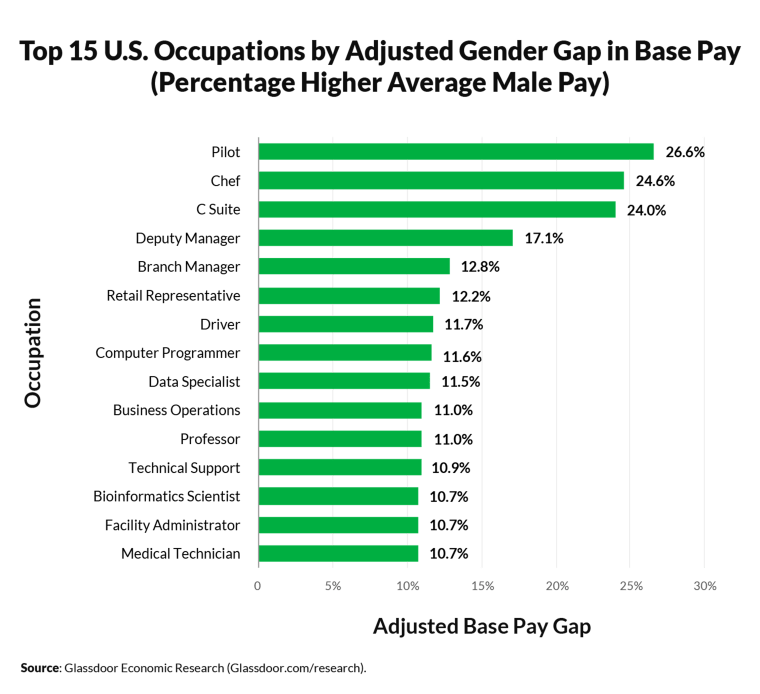Women continue to make about 80 cents for every dollar that men earn. And if you’re a female who is a pilot, chef or C-suite level executive, chances are, you fare even worse.
In the lead up to Equal Pay Day on April 2, Glassdoor.com released research on the 15 jobs with the biggest gender pay gaps, which climbed up to 26.6 percent in certain roles.

“Many of the jobs with the biggest gender pay gaps, like pilot, chef and C-suite, are positions that tend to be filled by men — and it’s important that we get more women into these types of roles and help close that gap,” said Alison Sullivan, a Glassdoor career trends expert.
The report also showed that while the adjusted pay gap has dropped from 6.5 percent in 2011 to 4.6 percent in 2018, if current trends continue, equal pay will not become a reality until 2070.
Lauren McGoodwin, founder and CEO of Career Contessa, a career site built for women, told Know Your Value that fewer women pursue employment in these fields because they are dominated by men. That means fewer women rise up into senior management or leadership positions in these areas as well.
“Getting women interested in these roles and communicating that they are able to pursue a job in these traditionally male-centric fields needs to start much earlier,” McGoodwin said.
She gave the example of teaching young girls they can be pilots and chefs, not just flight attendants or sous chefs. That also means giving girls toys like airplanes and spaceships instead of dolls and being aware of the language we use around girls.
“As more women join these fields and assume more senior and decision-making roles in them, they can then help change policies around flexibility by advocating for increasingly popular, non-traditional employment practices including open vacation options, flexible schedules like working remotely, paid family leave and health and wellness stipends,” McGoodwin said. “These new female role models will then hopefully serve as examples for the women coming up behind them.”
Shelley Zalis, founder of The Female Quotient, a Los Angeles-based company that works to advance workplace equality, believes that a lot of the jobs with the biggest gender pay gaps have cultural and systemic barriers, but she argued that “when passion meets purpose, it’s unstoppable.”
RELATED: 5 ways women can rise into leadership
While many of the jobs with big pay gaps are ones that are challenging for women in caregiver positions to pursue (such as a pilot flying to new destinations on a regular basis or a chef working late hours), Zalis believes that companies should accommodate different life stages to attract the very best talent. “Happier employees lead to better performance and higher retention,” she said.
The Glassdoor report also confirmed that the pay gap continues to widen as workers age.
“Early on in a worker’s career, the pay gap is smaller, but as they age the gap continues to widen,” Sullivan said. She explained that it’s important for women throughout their careers to understand their market value and be diligent about their pay. “Many of us go to the doctor yearly, the dentist twice a year,” Sullivan said. “We should do that for our pay too and initiate these conversations on a regular basis.”
“There truly is a mommy penalty,” Zalis said. She believes that better parental leave policies, or perhaps even mandatory maternity and paternity leave, could help shrink the gender pay gap.
McGoodwin said that above all else, women must not shy away from talking openly about pay and advocating for equal wages. She advised women to reach out to at least three men and three women at their company, or in similar roles at other companies, and ask them if they’d be willing to share their salary details or range.
“You can explain it’s because you believe in salary transparency and are doing research for your own career,” she said. “It’s a win-win because you’ll learn very quickly what the going rate for your industry is and you start a bigger conversation with people about salary transparency and gender equality.” Of course, if someone says, “no thanks,” McGoodwin assures that’s totally OK — and you can just move on to asking someone else who might be more open to it.
“Once you’re certain that the situation is truly unequal, set a time on your boss’s calendar and go in prepared with all your research,” McGoodwin said. “Then ask for a raise.”
Indeed, small steps like these — from recognizing the jobs with the biggest gender pay gaps and getting more women into leadership positions there to inquiring about pay transparency and asking for a raise — could all lead to major advancements when it comes to closing the gender pay gap once and for all.
